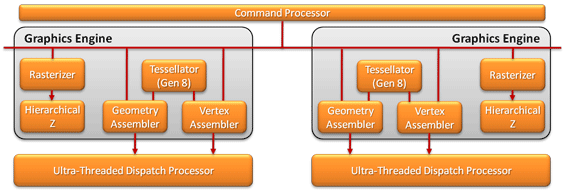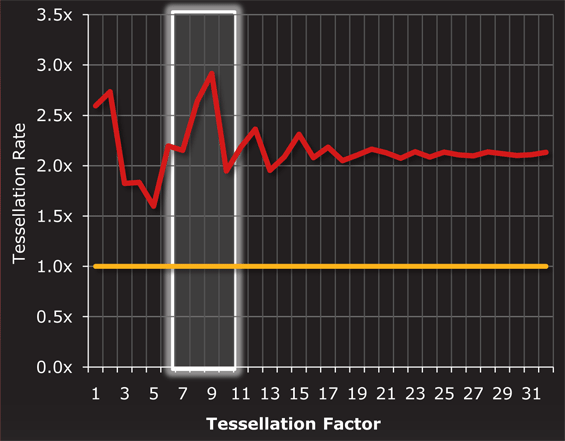AMD's Radeon HD 6970 & Radeon HD 6950: Paving The Future For AMD
by Ryan Smith on December 15, 2010 12:01 AM ESTAdvancing Primitives: Dual Graphics Engines & New ROPs
AMD has clearly taken NVIDIA’s comments on geometry performance to heart. Along with issuing their manifesto with the 6800 series, they’ve also been working on their own improvements for their geometry performance. As a result AMD’s fixed function Graphics Engine block is seeing some major improvements for Cayman.
Prior to Cypress, AMD had 1 graphics engine, which contained 1 each of the fundamental blocks: the rasterizers/hierarchical-Z units, the geometry/vertex assemblers, and the tessellator. With Cypress AMD added a 2nd rasterizer and 2nd hierarchical-Z unit, allowing them to set up 32 pixels per clock as opposed to 16 pixels per clock. However while AMD doubled part of the graphics engine, they did not double the entirety of it, meaning their primitive throughput rate was still 1 primitive/clock, a typical throughput rate even at the time.

Cypress's Graphics Engine
In 2010 with the launch of Fermi, NVIDIA raised the bar on primitive performance, with rasterization moved to NVIDIA’s GPCs, NVIDIA could theoretically push out as many primitives/clock as they had GPCs, in the case of GF100/GF110 pushing this to 4 primitives/clock, a simply massive improvement in geometry performance for a single generation.
With Cayman AMD is catching up with NVIDIA by increasing their own primitive throughput rate, though not by as much as NVIDIA did with Fermi. For Cayman the rest of the graphics engine is being fully duplicated – Cayman will have 2 separate graphics engines, each containing one fundamental block, and each capable of pushing out 1 primitive/clock. Between the two of them AMD’s maximum primitive throughput rate will now be 2 primitives/clock; half as much as NVIDIA but twice that of Cypress.

Cayman's Dual Graphics Engines
As was the case for NVIDIA, splitting up rasterization and tessellation is not a straightforward and easy task. For AMD this meant teaching the graphics engine how to do tile-based load balancing so that the workload being spread among the graphics engines is being kept as balanced as possible. Furthermore AMD believes they have an edge on NVIDIA when it comes to design - AMD can scale the number of eraphics engines at will, whereas NVIDIA has to work within the logical confines of their GPC/SM/SP ratios. This tidbit would seem to be particularly important for future products, when AMD looks to scale beyond 2 graphics engines.
At the end of the day all of this tinking with the graphics engines is necessary in order for AMD to further improve their tessellation performance. AMD’s 7th generation tessellator improved their performance at lower tessellation factors where the tessellator was the bottleneck, but at higher tessellation factors the graphics engine itself is the bottleneck as the graphics engine gets swamped with more incoming primitives than it can set up in a single clock. By having two graphics engines and a 2-primitive/clock rasterization rate, AMD is shifting the burden back away from the graphics engine.
Just having two 7th generation-like tessellators goes a long way towards improving AMD’s tessellation performance. However all of that geometry can still lead to a bottleneck at times, which means it needs to be stored somewhere until it can be processed. As AMD has not changed any cache sizes for Cayman, there’s the same amount of cache for potentially thrice as much geometry, so in order to keep things flowing that geometry has to go somewhere. That somewhere is the GPU’s RAM, or as AMD likes to put it, their “off-chip buffer.” Compared to cache access RAM is slow and hence this isn’t necessarily a desirable action, but it’s much, much better than stalling the pipeline entirely while the rasterizers clear out the backlog.

Red = 6970. Yellow = 5870
Overall, clock for clock tessellation performance is anywhere between 1.5x and 3x that of Cypress. In situations where AMD’s already improved tessellation performance at lower tessellation factors plays a part, AMD approaches 3x performance; while at around a factor of 5 the performance drops to near 1.5x. Elsewhere performance is around 2x that of Cypress, representing the doubling of graphics engines.
Tessellation also plays a factor in AMD’s other major gaming-related improvement: ROP performance. As tessellation produces many mini triangles, these triangles begin to choke the ROPs when performing MSAA. Although tessellation isn’t the only reason, it certainly plays a factor in AMD’s reasoning for improving their ROPs to improve MSAA performance.
The 32 ROPs (the same as Cypress) have been tweaked to speed up processing of certain types of values. In the case of both signed and unsigned normalized INT16s, these operations are now 2x faster. Meanwhile FP32 operations are now 2x to 4x faster depending on the scenario. Finally, similar to shader read ops for compute purposes, ROP write ops for graphics purposes can be coalesced, improving performance by requiring fewer operations.










168 Comments
View All Comments
DoktorSleepless - Wednesday, December 15, 2010 - link
What benchmark or game is used to measure noise?Hrel - Wednesday, December 15, 2010 - link
I'm not 100% but I believe they test it under Crysis. It was either that or a benchmark that put full load on the system. It was in an article in last year or 2, I've been reading so long it's all starting to mesh together; chronologically. But suffice it to say it stresses the system.Hrel - Wednesday, December 15, 2010 - link
It's furmark, it's in the article.Adul - Wednesday, December 15, 2010 - link
nice Christmas gift from the GF :DAstroGuardian - Wednesday, December 15, 2010 - link
I saw my GF buying a couple of those. One is supposed to be for me and she doesn't play games...... WTF?MeanBruce - Wednesday, December 15, 2010 - link
Wow, you are getting a couple of 6950s? All I am getting from my 22yo gf is a couple of size F yammos lying on a long narrow torso, and a single ASUS 6850. Don't know which I like better, hmmmmm. Wednesday morning comic relief.Adul - Wednesday, December 15, 2010 - link
damn sounds good to me :) enjoy both ;)SirGCal - Wednesday, December 15, 2010 - link
I'm happy to see these power values! I did expect a bit more performance but once I get one, I'll benchmark it myself. By then the drivers will likely have changed the situation. Now to get Santa my wish list... :-) If it was only that easy...mac2j - Wednesday, December 15, 2010 - link
One of the most impressive elements here is that you can get 2x6950 for ~$100 more than a single 580. That's some incredible performance for $600 which is not unheard of as the price point for a top single-slot card.Second... the scaling of the 6950 combined with the somwhat lower power consumption relative to the 570 bodes well for AMD with the 6990. My guess is they can deliver a top performing dual-GPU card with under a 425-watt TDP .... the 570 is a great single chip performer but getting it into a dual-gpu card under 450-500w is going to be a real challenge.
Anyway exciting stuff all-around - there will be a lot of heavy-hitting GPU options available for really very fair prices....
StormyParis - Wednesday, December 15, 2010 - link
It's nice to have all current cards listed, and helps determine which one to buy. My question, and the one people ask me, is rather "is it worth upgrading now". Which depends on a lot of things (CPU, RAM...), but, above all, on comparative perf between current cards and cards 1-2-3 generations out. I currently use a 4850. How much faster would a 6850 or 6950 be ?